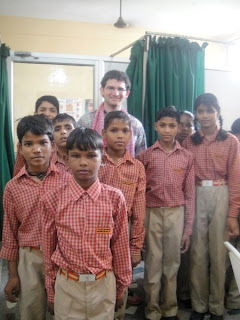I wanted to dedicate this post to discuss the hardships of the students who attend the charitable school where I have been volunteering. If you have been keeping up with the Ek Koshish blog, I have not been teaching there during the month of June, because it is currently their summer vacation; but, starting July 1st, we will be starting classes again, and I will continue my English grammar lectures with the help of a Hindi-speaking English teacher. Everyday at the end of school, I would wait outside for a “rickshaw waala” (what we call the person who drives the “rickshaw,” depicted in the photo above) while the children, who would hang around school after classes finished, would engage in conversation with me. The children explained how they really enjoyed coming to school, since they have a safe place to play with their friends, eat two meals, learn computers, and relish other entertaining subjects. Originally the children were not so interested in learning English, but, after my arrival, many of them felt urged to learn more English so that they could interact with me and learn more about the world outside of their little village in Faridabad, Delhi NCR. The students also explained that, though there is a bus that many students use to go home, not every student can be picked up by the bus: They have to walk about ten kilometers (approximately 6.2 miles) every day to school, in the blistering heat of 50˚C (122˚F), each way. It was a rude awakening to hear about their rough lives every day, considering that they enjoy walking to school, because home must be that much worse. In many cases, the children’s parents cannot afford to feed the children at all, and so the children go each day to eat two meals per day at the school, apart from Sundays, when the school is not open. It is my dream that these brave Indian students can be successful and can communicate fluently in English: Until then, my work here won’t be done!
Category Archives: Charitable School
Sharing US Currency with Indian Students
The other day at the charitable school, I was answering many questions the children had about my home in the US, to which they all paid close attention, listening in amazement. Several of the children were very interested in US currency, and they asked me “What is money like over there? Can you bring some American money for us to see?” Thankfully, I held onto a bunch of my singles and some change I had at the airport, and I brought in one of each coin, along with a single, a five, ten, and twenty dollar bill for them to observe. At the end of class today, the children made sure I didn’t forget to show them the currency, as they asked, “You did bring the money, right?” I pulled out the money from my pockets, from which they all derived great pleasure! They each were touching the dollars, asking who was on each different coin and bill, which buildings were depicted on each bill, how many rupees each coin or bill was worth, and much more. After they all relished this special moment they never had envisioned would occur, one of the students took out some Indian Rupees and was showing me what Indian currency looks like! The other students were explaining to him that I probably already know what Indian money here looks like; but even still, he kept showing me more coins and different bills! It was very sweet that he wanted to share with me the same excitement he experienced from looking at foreign money! In a few days, it will be the last day of the school before summer holidays, until July 1st, so I am looking forward to this last exciting week of classes until then!
Infirmary at the Charitable School
English Teaching Volunteer Impresses the Faculty
At the charitable school in Tigaon, Faridabad, the teachers have been very impressed with our volunteer’s consistent work and contemporary methods for teaching the children English. In India, and especially in this school, most of the teaching encourages only students who can learn from rote memorization. Though rote memorization is extremely helpful, Ek Koshish feels that we can complement such methods with teaching for understanding the material as well, once enough material has been memorized. For example, our volunteer explained to us that he had asked the children to properly arrange the words in the sentence “There everywhere water is.” When the first student responded, he started answering the question by saying “Water everywhere,” when a teacher stopped him and said it was incorrect. The English teacher who assists our volunteer in all of the classes later explained to the other teacher, “Let the student make the mistake and think through the sentence. Then, Justin ji [our volunteer] explains what is wrong with their sentence, and lets them try again so that they can reach the correct answer on their own. This is how Justin ji teaches, so that the children can understand how to fix their own mistakes. It’s been very helpful.” The other teacher then observed him explaining to the child how to fix the sentence, and when he could make the sentence “There is water everywhere” she was very impressed! Let’s see if he can keep dazzling the teachers with his performance!

